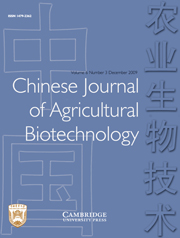Article contents
RAPD analysis on genetic diversity of typical tea populations in Hunan Province
Published online by Cambridge University Press: 27 June 2008
Abstract
Genetic diversity and genetic variation of 240 adult plants of four tea populations in Hunan – Camellia sinensis var. sinensis, C. sinensis var. assamica cv. Duntsa, C. ptilophylla and C. sinensis var. assamica cv. Jianghua – were studied by rapid amplification of polymorphic DNA (RAPD) markers. The results showed 226 loci using 21 random primers (10 bp), of which 201 (88.9%) were polymorphic. The genetic diversity analysis indicated that Shannon's index was 0.43; 74.7% of which was within-population genetic diversity while 25.3% was among-population variation. The gene diversity indexes of total populations (HT), within populations (HS) and among populations (HST) were, respectively, 0.37, 0.28 and 0.09. The coefficient of gene differentiation (GST) among populations was 0.23, indicating a 76.7% variation within populations and 23.3% among populations. These results displayed a rich within-population genetic variation, as in Shannon's diversity index. Interpopulation gene flow (Nm) was 0.74, which indicates the limited genetic exchange between populations.
- Type
- Research Papers
- Information
- Copyright
- Copyright © China Agricultural University 2008
Footnotes
First published in Journal of Agricultural Biotechnology 2007, 15(5): 855–860
References
- 1
- Cited by


